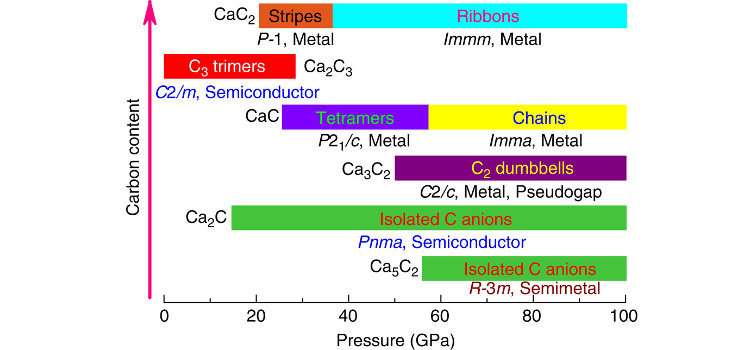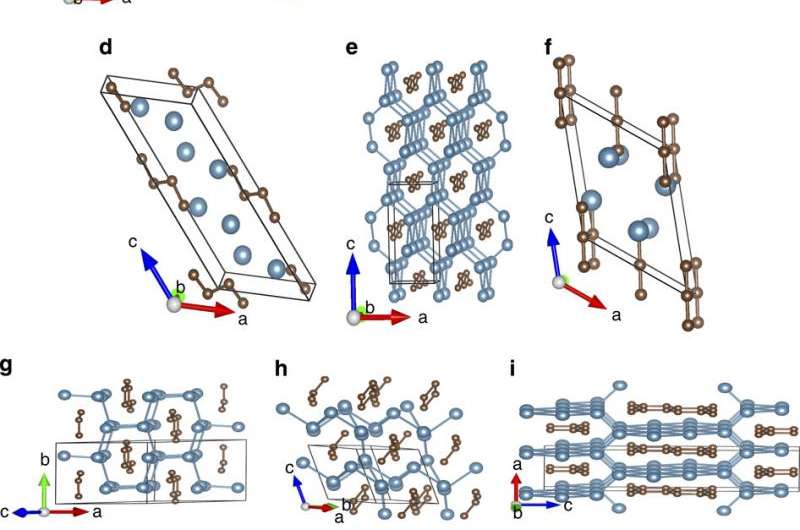Unique reducers and new hydrocarbon synthesis methods for five new calcium carbides

A team led by MIPT Professor Artem Oganov has used computer simulation to predict the existence of five completely new compounds of carbon and calcium with varied chemical and physical properties, obtaining two of them by experiment. The journal Nature Communications has published an article featuring the results of the study.
Calcium carbide (CaC2) is not a rare chemical compound: you may have come across these small white rocks from which acetylene for gas welding and fertilizer are produced. There is also a more exotic form of a calcium and carbon compound, calcium hexacarbide (CaC6), which becomes a superconductor at relatively high temperatures of 11.5 Kelvin.
The Oganov group has discovered that the variety of carbon and calcium compounds is not limited to these two substances. Using computer simulation, they found that at least five other carbides can exist under certain conditions.
The scientists specialize in searching for compounds that seem impossible, as their existence runs counter to known chemical laws. Using the chemical compound simulation algorithm USPEX developed by Professor Oganov, they predicted the existence of "nonstandard" salts of sodium and chlorine, NaCl3, NaCl7, Na3Cl2, Na2Cl and Na3Cl, which broke the laws of chemistry, and then obtained these compounds during experiments. They also discovered several "nonstandard" aluminum oxides, magnesium oxides and other substances.

Calcium and carbon compounds attracted the group's attention because the structural and electronic properties of both elements vary greatly at different pressures. In particular, at a pressure of 216 GPa, calcium shows the highest superconducting transition temperature (29 K) among pure elements.
Using the USPEX simulator, the scientists analyzed the properties of all possible carbides that can be synthesized at pressures ranging from normal to 100GPa and detected five possible substances: Ca5C2, Ca2C, Ca3C2, CaC and Ca2C3.
Their calculations showed thatCa2C3remains stable at pressures below 28 GPa, Ca5C2 at pressures above 58 GPa, Ca2C - above14 GPa, Ca3C2 - above 50GPa, CaC - above 26GPa, and CaC2 -above 21 GPa. The crystal lattices of these compounds contain carbonic structures, with shapes ranging from dumbbells to belts and layers consisting of hexagons.
Ca2C proved to be the most peculiar compound. Like graphene, it has the structure and properties of a two-dimensional metal. Graphene is a carbonic material, the synthesis of which earned Andre Geim and Konstantin Novoselov the 2010 Nobel Prize. But unlike graphene, in Ca2C electric current goes along the layers of calcium atoms, not carbon atoms, and there are clumps of free electrons in the calcium layers.
To confirm their theoretical predictions, Oganov's group carried out an experiment to synthesize the compounds. They placed a mixture of calcium and carbon into a so-called diamond anvil cell, a chamber in which a material sample is squeezed between two diamonds. Pressures may reach hundreds of GPa in such a chamber.
The scientists registered the synthesis of Ca2C3 at pressures exceeding 10 GPa and temperatures near 2000 K, whileCa2C was observed when pressures exceeded 22 GPa. Using synchrotron radiation, the group was able to confirm the existence of structures they predicted theoretically.
"It's possible to find practical applications for these unusual substances, if they are synthesized in sufficient quantities," Oganov said.
Two-dimensional carbides with free electron clumps are unique reducers and can be used in the chemical industry. Carbides with three or more carbon atoms can be utilized to synthesize uncommon hydrocarbons, Oganov added.
More information: "Investigation of exotic stable calcium carbides using theory and experiment." Nature Communications 6, Article number: 6974 DOI: 10.1038/ncomms7974
Journal information: Nature Communications
Provided by Moscow Institute of Physics and Technology




















